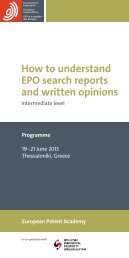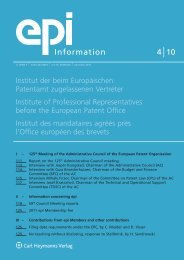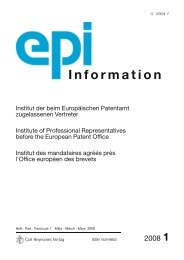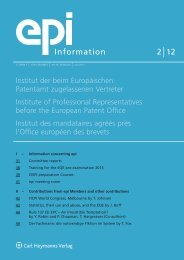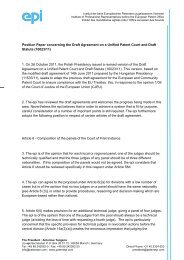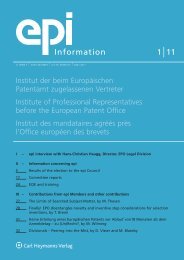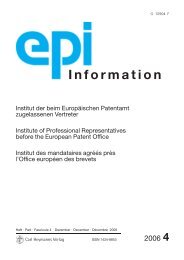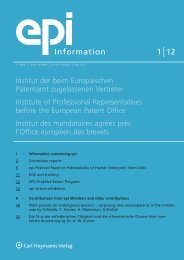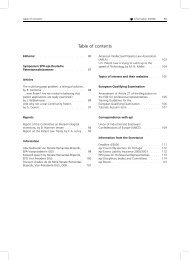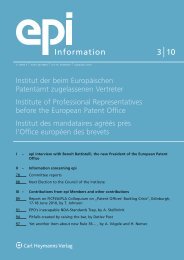epi Information 2/2009
epi Information 2/2009
epi Information 2/2009
You also want an ePaper? Increase the reach of your titles
YUMPU automatically turns print PDFs into web optimized ePapers that Google loves.
<strong>Information</strong> 2/<strong>2009</strong> Articles 57<br />
IV – Discussion of this Board of Appeal’s decision<br />
T1143/05:<br />
1 – In T1143/05, the Board held that EP1 is opposable as<br />
prior art against EP2. This legal consideration is right only<br />
if the priority is invalid.<br />
Thus, as a consequence of invalidity of the Priority<br />
Right, EP1 becomes a prior art falling within the definition<br />
of Article 54(3) (prior rights). No basis is given in the<br />
EPC to consider the contrary.<br />
According to the Board’s assertion that the priority is<br />
invalid, the examples of EP1 disclosing the combination<br />
of MITand BIT destroy the novelty of the subsequent EP2.<br />
This position is in our opinion contradictory, notably in<br />
the present case where a particular embodiment is<br />
excluded from the scope of claim 1.<br />
Indeed, the priority EP1 destroys novelty of EP2 claims<br />
only if new matter is added in EP2. Accordingly what is<br />
important is to study whether new matter was added<br />
between EP1 and EP2.<br />
We will debate this later on, after examining direct<br />
consequences and our proposed recommendations<br />
further to the Board’s interpretation.<br />
2 – First, this Board’s decision may apply to any<br />
amendment performed after the filing of a first European<br />
application EP1 and introducing new subject<br />
matter in the main claim of a subsequent European<br />
application EP2. Accordingly, new fall-back positions in a<br />
subsequent European application EP2 claiming the priority<br />
of EP1 render highly probable the priority invalid and<br />
EP1 opposable to EP2.<br />
As a result EP1 priority application text is a killing prior<br />
art under Art. 54(3)EPC against EP2. Therefore it is<br />
recommended to include all fall-back positions in the<br />
priority application. We thus insist on the importance of<br />
a careful drafting of the priority application EP1for<br />
ensuring the full validity of the future priority claim.<br />
This decision T1443/05 is all the more important as,<br />
according to EPC2000, EP1 is opposable under Art. 54(3)<br />
for all contracting states, so that EP2 will be invalid for all<br />
contracting states.<br />
3 – A legal remedy to the above described situation is<br />
the withdrawal of the priority application EP1 before<br />
publication to avoid EP1 publication. In this case EP1 will<br />
not be opposable to EP2. This has been confirmed in the<br />
EPO’s decision J5/81 (Hoermann KG Brockhagen).<br />
4 – Further, it should be avoided to file of a European<br />
or of a PCT application as a first filing to avoid the above<br />
situation or to file a priority national Application to limit<br />
its impact to the (European) country of the first filing.<br />
5 – Besides, this BOARD’s decision is disadvantaging<br />
the EP first filing European Applicants as compared to<br />
National Applicants who are not concerned by such a<br />
legal problem since the priority National application is<br />
not opposable under Art. 54(3) to the subsequent European<br />
patent. It is probable that not all national Courts<br />
will follow this EPO’s decision T1143/05. Further, the<br />
„non-European“ priority application is not opposable to<br />
the subsequent European application, so that non-European<br />
applicants do not have to take into account this<br />
decision and interpretation of the EPC.<br />
6 – In T1143/05, the Board interpreted in much more<br />
restrictive manner than in G2/98 the terms „same invention“.<br />
In T1143/05, the Board held that the same invention<br />
means more or less the same wording.<br />
In addition, the Board held that the technical problem<br />
is to provide a biocide composition comprising MIT and<br />
BIT but not inducing allergy. Accordingly, for the Board,<br />
the technical problem defined is clearly not the same as<br />
the one defined in the priority EP1 and the priority is<br />
invalid.<br />
But we consider that the Board’s assertion that the EP2<br />
is not claiming the same invention as the priority EP1<br />
should not be held as acceptable because the disclaimer<br />
of CMIT is not changing the invention nor the technical<br />
problem solved, i. e. the technical problem of providing a<br />
biocide composition showing a synergistic effect<br />
between MIT and BIT.<br />
The closest prior art was a Japanese Patent Application<br />
JP 01-224306 („JP“) disclosing biocide compositions<br />
showing a synergistic effect and comprising MIT, BIT<br />
and CMIT.<br />
No reference was made to any synergy of MIT and BIT<br />
in this JP. Accordingly, it cannot be obviously deduced<br />
from the JP prior art that MIT and BIT show a synergistic<br />
effect.<br />
It is apparent that the disclaimer was introduced in EP2<br />
to overcome this JP prior art disclosure. It is also understandable<br />
that limiting the invention of EP2 to biocide<br />
composition comprising only or exclusively MITand BITas<br />
biocide agent would have no or very limited commercial<br />
interest.<br />
In the present decision T1143/05, the working<br />
examples of both the subsequent EP2 and the priority<br />
EP1 show the synergy of biocide compositions comprising<br />
only MIT and BIT. Other biocide agent are presented<br />
as further possible biocide agents.<br />
Accordingly, there is no ground to consider that a<br />
skilled person would not have derived directly and<br />
unambiguously from the disclosure of EP1 that the<br />
priority EP1 disclosed the invention, i. e. biocide compositions<br />
comprising MIT and BIT. It should not be forgotten<br />
that Article 87 EPC refers to the „same invention“.<br />
A skilled person would understand at the time of filing<br />
that essential means of EP1 are the synergistic presence<br />
of MIT and BIT, and that all other biocide ingredients are<br />
optionally present, i. e. may be excluded from the composition.<br />
We believe that an embodiment disclosed in an<br />
application may be excluded if this embodiment is not<br />
one essential technical feature claimed or presented as<br />
essential in the application. This is line with T1139/00<br />
which held that „[t]he effect of a disclaimer in the claims<br />
is to exclude one particular process from the group of<br />
processes, to leave a more limited group, which merely<br />
narrows the scope of the claims“.



